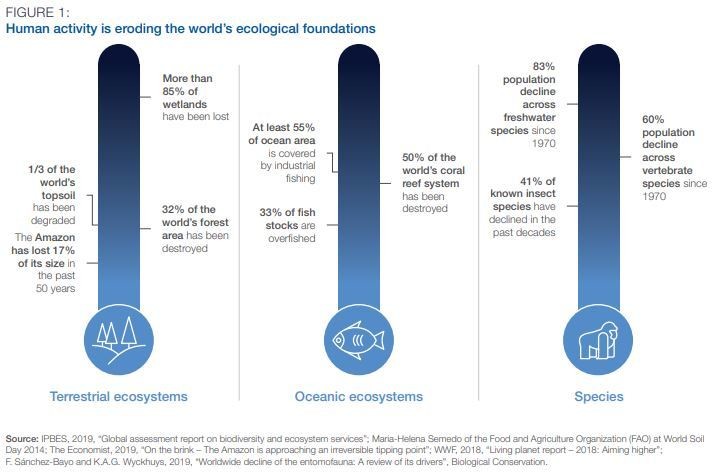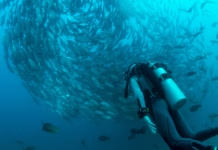Written by: Akanksha Khatri and Alexia Semov
We often take the contribution of nature and its ecosystem services for granted in our food production systems. Forests and oceans provide many of our natural resources, and we all benefit from healthy soils, clean water, pollination and a stable climate. All of these come for free and are therefore easy to dismiss as a given. But this is far from the truth.
Current rates of nature and biodiversity loss are having a substantial impact on what we eat and how we feed the world’s populations. And this impact is set to increase.
According to World Economic Forum research, in collaboration with PwC, $44 trillion of economic value generation – more than half of the world’s total GDP – is moderately or highly dependent on nature and its services, and therefore exposed to risks from nature loss. Agriculture and the food and beverages industries are the second- and third-largest sectors most dependent on nature, after the construction industry.

Nature loss has a high cost to our food systems.
Climate change, soil erosion, pollinators extinction and deforestation are some of the threats to food supplies.
For example, 60% of coffee varieties are in danger of extinction. If this were to happen, global coffee markets – a sector with retail sales of $83 billion in 2017 – would be significantly destabilized, affecting the livelihoods of many smallholder farmers
The decline of insects and other animals that pollinate crops is also worrying for agriculture production. More than three-quarters of the world’s food crops rely at least partially on pollination. In other words, global crop production with an annual market value of between $235 billion and $577 billion is at risk.
Outbreaks of invasive pests and diseases are another common cause of nature loss that threatens the survival of commercially important crop species with low genetic diversity. More than half of the world’s food comes from just three staples – rice, wheat and maize – which already suffer annual losses of up to 16% of total production (valued at $96 billion) due to invasive species.
There are also costs to human lives and communities.
Nature loss is particularly dire for the rural poor and their economic development. Rural communities are often directly and heavily dependent on nature for their food, shelter, income, fuel, health and way of life. They are more vulnerable to its loss since substitutes are often unavailable or too costly. In India, for example, while forest ecosystems contribute only 7% to India’s GDP, they contribute to 57% of rural Indian communities’ livelihoods.
Nature loss also has a disproportionate impact on women and children, as women play a vital role in managing biological resources such as fuel, food and water. As increased gender equality is a driver of economic growth, the adverse impacts of nature loss on women have wider implications for economic development
In addition, the degradation and loss of natural systems can affect health outcomes linked to food consumption. For example, the onset of infectious diseases has been connected to ecosystem disturbance. Outbreaks of animal-transmitted diseases like Ebola and the Zika virus has been found to be strongly correlated to deforestation in these areas.
COVID-19 is believed to have been transferred from wildlife to humans, causing some to call for a ban on illegal wildlife trade, as a matter not only of conservation but of public health and safety.
We must change our relationship with nature.
The accelerating negative impact of human activities on biodiversity and nature cannot be tackled without a radical reset of humanity’s relationship with nature.
Companies, investors, policymakers and civil society must work together to halt nature loss by 2030. We must reframe of the financial materiality of nature risks to businesses, financial institutions, asset owners, regulators and governments, making sure these risks are regularly identified, assessed and disclosed by business – as is now routinely the case for climate risks. We can do this by framing nature risks as part of enterprise risk management and environment, social and governance (ESG) practices
We can also learn lessons for nature-related risks from the framework proposed by the G20-initiated Task Force on Climate-related Financial Disclosures (TCFD) for identifying, measuring and managing climate risks, which has already been broadly adopted and endorsed by businesses
The next step is to identify what strategic transitions are needed to halt and reverse nature loss and show how businesses can be part of the solution, paving way for new opportunities and business models, as well as ways to finance this transformation.
There is a significant opportunity for humanity to invest in nature to fight climate change, which has been identified as the greatest challenge of our time. One concrete way to do this is by reforming how and what foods we grow, manage, consume and recycle.
Additionally, if we are truly to shift towards a nature-positive pathway, the energy and extractives as well as the infrastructure sectors must join the movement towards a systems transformation. Significant upside opportunities await those who will embark on this journey, but it will not be easy.
As the state of planetary emergency becomes clearer, we must raise ambition for safeguarding nature which underpins every human activity on the only planet we have.
Republished with permission from World Economic Forum







